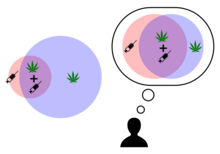Confusion of the Inverse

Confusion of the inverse ( Engl. For "confusing the reversal"; also: Conditional Probability Fallacy [ "fallacy of the conditional probability"], inverse fallacy [ "reversal fallacy"], Fallacy of the Transposed Probability [ "fallacy of the transposed probability"] Prosecutor's Fallacy is a logical fallacy that consists in equating a conditional probability with its reversal.
A conditional probability (e.g. the probability that a professor in Germany is a woman: 25%) is by no means identical to its inverse (the probability that a woman is a professor in Germany: 0.03%). With Confusion of the Inverse , however, this difference is not understood and one value is incorrectly used for the other.
The American psychologist Robyn Dawes coined the term Confusion of the Inverse .
Examples
General examples
“As has been shown in a study, almost every second terrorist has completed technical training. Parents who offer their child a technical education should be prepared for the child to embark on a career in terrorism. "
“Most accidents happen at home. To be sure, you should stay at home as little as possible. "
"Most drug addicts have the gateway drug started hashish. Anyone who smokes hashish runs a high risk of later becoming addicted to harder drugs. "
Examples from medicine
The confusion of the inverse is widespread among students and academics and leads to serious and sometimes momentous distortions, especially in the interpretation of medical test results.
| Relative size |
Vicious | Benign | total |
|---|---|---|---|
| Test positive |
0.8 (correct positive) |
9.9 (false positive) |
10.7 |
| Test negative |
0.2 (false negative) |
89.1 (correct negative) |
89.3 |
| total | 1 | 99 | 100 |
One of the best-known examples today is one pointed out by David M. Eddy in 1982. Eddy asked 100 doctors to comment on the following case: A patient has a lump in her breast. A mammography provides the finding that the tumor is malignant. The doctor knows that:
- Only 1% of all breast tumors are malignant.
- Mammograms identify a malignant tumor as such in 80% of the cases (while they incorrectly classify it as benign in 20% of the cases).
- Mammograms identify a benign tumor as such in 90% of the cases (while they incorrectly classify it as malignant in 10% of the cases).
Most of the doctors surveyed by Eddy put the probability that the patient had a malignant tumor at 75% (0.75). Correctly, but calculated using Bayes' theorem , the risk is only 7.5% (0.075).
As early as 1979, two researchers from Massachusetts had shown similar systematic misinterpretations in advance of medical prescriptions of amniocenteses in pregnant women.
literature
- Pavel Kalinowski, Fiona Fidler, Geoff Cumming: Overcoming the Inverse Probability Fallacy: A Comparison of Two Teaching Interventions . In: Methodology European Journal of Research Methods for the Behavioral and Social Sciences . tape 4 , no. 4 , January 2008, p. 152-158 .
Web links
- Richardo Franco, Jerome Busemeyer: A quantum probability explanation for the inverse fallacy. Retrieved July 14, 2020 (Indiana University).
Individual evidence
- ↑ Christopher J. Wild, Jessica M. Utts, Nicholas J. Horton: What Is Statistics? In: Dani Ben-Zvi, Katie Makar, Joan Garfield (Eds.): International Handbook of Research in Statistics Education . Springer, ISBN 978-3-319-66193-3 , pp. 5–36, here: p. 24 ( limited preview in Google book search).
- ↑ Scott Plous: The Psychology of Judgment and Decision Making . McGraw-Hill, 1993, ISBN 978-0-07-050477-6 , pp. 132 .
- ^ Diego Gambetta, Steffen Hertog: Engineers of Jihad: the curious connection between violent extremism and education . Princeton University Press, Princeton, Oxford 2016, ISBN 978-0-691-14517-4 .
- ↑ a b David M. Eddy: Probabilistic reasoning in clinical medicine: Problems and opportunity . In: Daniel Kahneman, Paul Slovic, AAmos Tversky (Eds.): Judgment under Uncertainty: Heuristic and Biases . Cambridge University Press, Cambridge 1982, ISBN 978-0-521-28414-1 , pp. 249-267 . Quoted from: Jessica Utts, Robert Heckard: Statistical Ideas and Methods . Thomson, Belmont, CA 2006, ISBN 0-534-40284-4 , pp. 234 ( limited preview in Google Book search).
- ↑ Susan P. Pauker, Stephen G. Pauker: The amniocentesis decision: an explicit guide for parents . In: Birth Defects Original Article Series . tape 15 , 5C, 1979, pp. 289-324 , PMID 160805 .
![{\ displaystyle {\ begin {aligned} & {} \ qquad P ({\ text {malicious}} | {\ text {positive}}) \\ [8pt] & = {\ frac {P ({\ text {positive }} | {\ text {malicious}}) P ({\ text {malicious}})} {P ({\ text {positive}} | {\ text {malicious}}) P ({\ text {malicious}} ) + P ({\ text {positive}} | {\ text {benign}}) P ({\ text {benign}})}} \\ [8pt] & = {\ frac {(0.80 \ cdot 0 , 01)} {(0.80 \ cdot 0.01) + (0.10 \ cdot 0.99)}} = 0.075 \ end {aligned}}}](https://wikimedia.org/api/rest_v1/media/math/render/svg/4afbc3b1439369d1457a95ac47a8f769bbfa70cf)